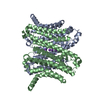+Search query
-Structure paper
| Title | Differential ion dehydration energetics explains selectivity in the non-canonical lysosomal K channel TMEM175. |
|---|---|
| Journal, issue, pages | Elife, Vol. 11, Year 2022 |
| Publish date | May 24, 2022 |
 Authors Authors | SeCheol Oh / Fabrizio Marinelli / Wenchang Zhou / Jooyeon Lee / Ho Jeong Choi / Min Kim / José D Faraldo-Gómez / Richard K Hite /   |
| PubMed Abstract | Structures of the human lysosomal K channel transmembrane protein 175 (TMEM175) in open and closed states revealed a novel architecture lacking the canonical K selectivity filter motif present in ...Structures of the human lysosomal K channel transmembrane protein 175 (TMEM175) in open and closed states revealed a novel architecture lacking the canonical K selectivity filter motif present in previously known K channel structures. A hydrophobic constriction composed of four isoleucine residues was resolved in the pore and proposed to serve as the gate in the closed state, and to confer ion selectivity in the open state. Here, we achieve higher-resolution structures of the open and closed states and employ molecular dynamics simulations to analyze the conducting properties of the putative open state, demonstrating that it is permeable to K and, to a lesser degree, also Na. Both cations must dehydrate significantly to penetrate the narrow hydrophobic constriction, but ion flow is assisted by a favorable electrostatic field generated by the protein that spans the length of the pore. The balance of these opposing energetic factors explains why permeation is feasible, and why TMEM175 is selective for K over Na, despite the absence of the canonical selectivity filter. Accordingly, mutagenesis experiments reveal an exquisite sensitivity of the channel to perturbations that mitigate the constriction. Together, these data reveal a novel mechanism for selective permeation of ions by TMEM175 that is unlike that of other K channels. |
 External links External links |  Elife / Elife /  PubMed:35608336 / PubMed:35608336 /  PubMed Central PubMed Central |
| Methods | EM (single particle) |
| Resolution | 2.45 - 2.61 Å |
| Structure data | EMDB-26626, PDB-7unl: EMDB-26627, PDB-7unm: |
| Chemicals |  ChemComp-K:  ChemComp-HOH: |
| Source |
|
 Keywords Keywords |  MEMBRANE PROTEIN / MEMBRANE PROTEIN /  potassium channel potassium channel |
 Movie
Movie Controller
Controller Structure viewers
Structure viewers About Yorodumi Papers
About Yorodumi Papers








